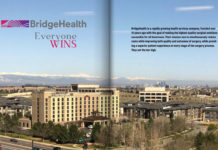
All Hands on Deck
Â

Nova Scotia’s EHS is a role model for provincial partnerships
Nova Scotia is, by anyone’s measure, a different kind of place.
It is Canada’s easternmost contiguous province, more than 13 hours from the national capital in Ottawa and another three hours removed from the country’s most populous city in Toronto. And it’s surrounded by water, save for a narrow isthmus tethering it to its mainland neighbor in New Brunswick.
The rugged climate provides for wide weather disparities from north to south, and it’s no rare feat to have one end of the province basking in sunshine while the other is hunkering down to fend off the effects of yet another incoming Atlantic Ocean-influenced storm system.
Yet, while all that novelty might stir differing perceptions of the place as a viable business locale, it’s that uniqueness in which the province designed an Emergency Medical System (EMS) that leverages public-private partnerships to ensure a safe, innovative, cost-effective and high-performance system.
In fact, the geographic and demographic nature of Nova Scotia make it a perfect setting for developing excellence in EMS system design and quality patient care.
IN THE BEGINNING
It’s a far cry from where the process began two decades ago.
Back then, the province collectively relied on private, public and funeral home ambulance companies for service that was loosely overseen by the Ambulance Operators Association of Nova Scotia, but whose quality, equipment and standards often varied significantly by location and provider. Meanwhile, air transport was typically provided when necessary by Canadian armed forced stationed nearby.
An early 1990s report commissioned by the provincial minister of health offered a comprehensively grim evaluation of the state of Nova Scotia’s emergency service offerings, and recommendations made in the report ultimately led to their takeover by Emergency Health Services.
These days, the EHS system is comprised of many public-private partnerships across ground ambulance, air ambulance, communications and innovative programs.
It doesn’t own the ambulances or aircraft, nor does it run the hospitals where some emergency patients eventually wind up for further treatment. EHS is designed after the public utility model where government becomes a good purchaser of services.
Key foundational principles include a failsafe system design, third-party validation through multiple accreditation processes, performance and evidence-based/informed programs, health system partnerships, public accountability, performance incentives, healthy public-private relationships and a focus on innovation.
Most importantly, the end result of the system design in Nova Scotia is the benefits to patients served.
This includes consistent and quality care, quality equipment, system accountability and appropriate oversight. Benefits to the province include quality care to citizens, financial certainty, quality equipment for the system providers and lower cost. In addition, broad economic benefits including local employment and new revenue into the province, a “made in Nova Scotia†solution and integration into the broader healthcare system are realized.
EHS’s reach now includes a centralized provincial medical communications and dispatch center, the Nova Scotia Trauma Program, and a medical first response program in which emergency responder agencies respond to stabilize life-threatening situations until paramedics arrive on scene.
Additionally, EHS’s Extended Care Program provides specialized care focused on the unique needs of nursing home patients, the RESTORE program enables delivery of pre-hospital thrombolytic drugs to lessen impacts of heart attacks and its MedicAlert Interchange Project allows e-access to patient care records while en route to an emergency scene.
STAYING BUSY
Tony Eden, the director of ground ambulance and medical communication services, says EHS handles more than 140,000 ambulance calls per year, nearly half of which are what he described as “routine,†many consisting of simple, scheduled transports from one facility to another. The other half are of an emergency or “urgent†variety, along with 1,000 or so requests for air service.
“Everyone in leadership roles has a background as a clinical practitioner, so we understand patient care and how it’s supposed to work,†he says. “It is first and foremost about quality patient care. The second element is the timing of the service. Of course, the whole cost and value question is important, too. Anyone can run a good ambulance service if they have an unlimited budget, which we don’t, so that brings into account the value and accountability of our operations.â€
The system’s centralized setup enables EHS to establish uniformity on standards, equipment, training, certification, etc., which guarantees that personnel responding to an accident scene in Sydney or Yarmouth on the northeast and southwest ends of the province will have the same qualifications as the crew arriving for a home-based emergency in suburban Halifax.
“Having that single standard of care and protocols for the whole province is vitally important,†says Chris Nickerson, director of provincial programs. “The ambulances, the equipment, the telecommunications, they’re all the same, so there’s a continuity and an assurance that there is consistency of operations and quality. One of the primary variables that is managed within the system is response to urban, rural and remote communities – the level of quality for all is exactly the same.â€
Of course, a public-private partnership-based model puts a premium on communication between partners.
WORKING WELL WITH OTHERS
Roles are established and clearly defined, which guards against redundancies and other cracks through which inefficiency could creep in, Nickerson says. For example, significant effort is put into ongoing education and quality improvement initiatives across the system.
Ultimately, that means EHS oversight of all the moving parts is critically important.
Benefits to private partners in the EHS system include long-term contracts, certainty, performance-based incentives, leverage of profile with other jurisdictions leading to additional business opportunities, and an integrated provincial system allows opportunity for innovative solutions and models of service delivery – such as the extended care paramedic and community paramedicine models.
“We strategically work closely with our partners so we all understand desired outcomes and expectations. When people go in to do a job, they understand what the expectations are and what they need to do to perform,†Eden says. “All of us are working together.
“The outcome of the design has been excellent patient care province-wide, high public confidence in the EMS system, international recognition and profile of the system, leader in model design for other jurisdictions and third-party validation of system design and performance through multiple accreditations. The system is a ‘made in Nova Scotia’ solution that is high-quality, affordable and sustainable.â€
Nickerson concurs, while simultaneously looking forward to a bright future, with even more to do.
“When there’s a 911 call, we have to be there,†he says. “The system will respond.â€
Many communities in Canada and the United States think about the three public safety organizations – police, fire and ambulance – as the more historical first responders. But that will change going forward, he says.
“We’re drifting away from that. We’re not exclusively focused on our public safety role,†Nickerson says. “Not only are we a co-responder with public safety, we’re also about mobile healthcare and we have moved into the realm of an enhanced role in primary care in communities across Nova Scotia.â€








